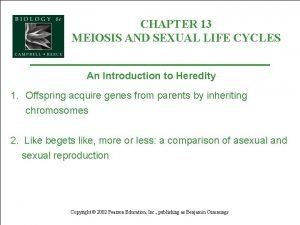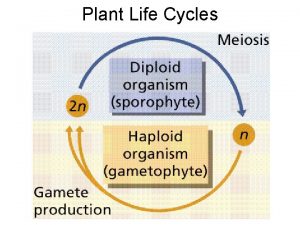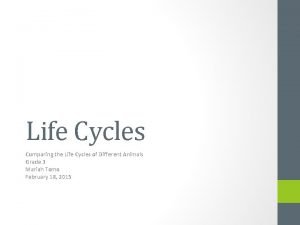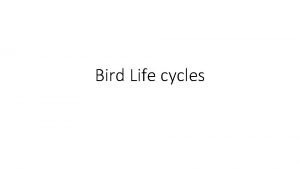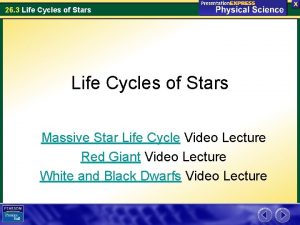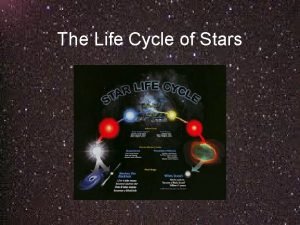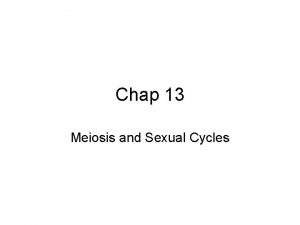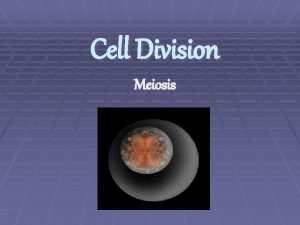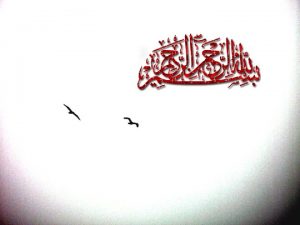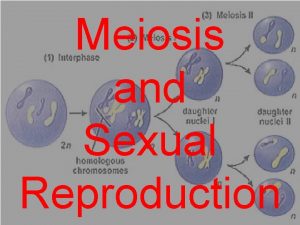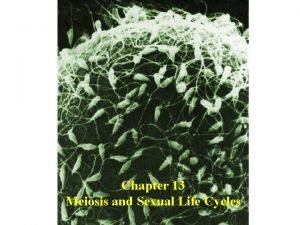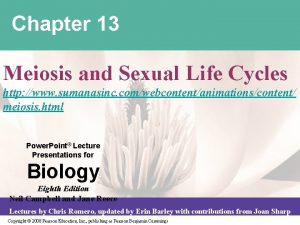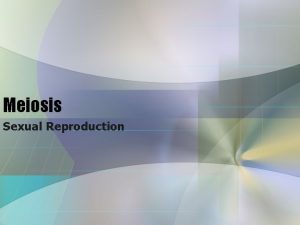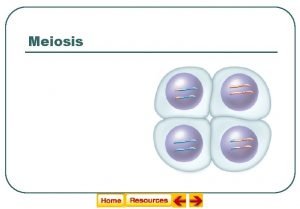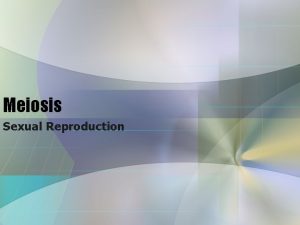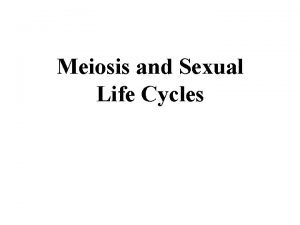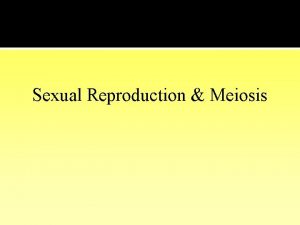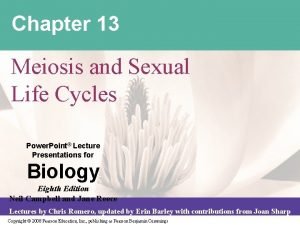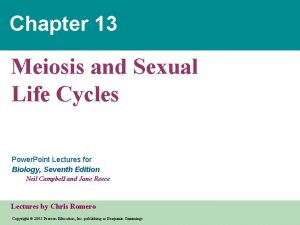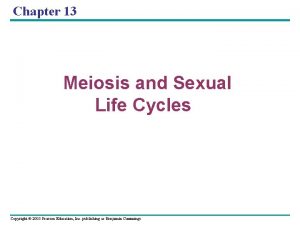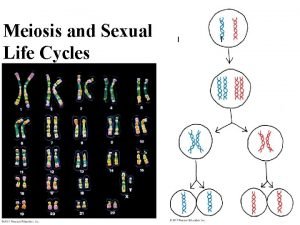Meiosis and Sexual Life Cycles http geneticsmadeeasy compreguntaspregunta

















- Slides: 17

Meiosis and Sexual Life Cycles http: //geneticsmadeeasy. com/preguntas/pregunta 30. html

Heredity 4 Heredity: the transmission of traits from one generation to the next 4 Asexual reproduction: clones 4 Sexual reproduction: variation 4 Human life cycle: – – – 23 pairs of homologous chromosomes (46) 1 pair of sex and 22 pairs of autosomes gametes = haploid (1 N) Autosomes = diploid (2 N) fertilization (syngamy) results in a zygote 4 Meiosis: cell division to produce haploid gametes

Alternative life cycles 4 Fungi/some algae – meiosis produces 1 N cells that divide by mitosis to produce 1 N adults (gametes by mitosis) 4 Plants/some algae – Alternation of generations: • 2 N sporophyte produces 1 N spores, by meiosis • spore divides by mitosis to generate a 1 N gametophyte • gametes then made by mitosis which then fertilize into 2 N sporophyte

Meiosis 4 Occurs only in the reproductive organs (gonads) 4 Formation of gametes – spermatogenesis in the testes – oogenesis in the ovaries 4 Allows for variation in offspring 4 Preceded by chromosome replication (chromatid pairs) 4 Followed by 2 cell divisions (Meiosis I & Meiosis II) 4 Results: – 4 daughter cells – 1/2 chromosome number (1 N http: //www. sinauer. com/cooper/4 e/animations 1607. html

Prophase I (1 cell ) 4 Nucleus disappears, spindle fibers form, and the chromatid pairs visible. 4 Chromatid pairs find their homologous pair, forming a tetrad (bivalent). 4 Homologous chromosomes are 2 of the same type of chromosomes. – Crossing over - 2 homologous chromosomes switch pieces of DNA. – Chiasma site of crossing over

Metaphase I (1 cell ) 4 Tetrads meet at the middle of the cell.

Anaphase I (1 cell ) 4 The tetrads split apart. 4 Homologous chromosomes split

Telophase I (2 cells ) 4 Two cells form 4 Each have a full set of chromosomes as chromatid pairs.

Prophase II (2 cells ) 4 Chromatid pairs continue moving to the center of the cell.

Metaphase II (2 cells ) 4 The chromatid pairs meet at the middle.

Anaphase II (2 cells ) 4 The chromatid pairs split apart.

Telophase II (4 cells) 4 Each of the two cells split making a total of 4 cells. 4 Each cell contains 1/2 the normal number of chromosomes. http: //bcs. whfreeman. com/thelifewire/content/chp 09/0902002. html http: //www. sumanasinc. com/webcontent/animations/content/meiosis. html

Meiosis vs. mitosis 4 Synapsis/tetrad/chiasmata/ crossing-over (prophase I) 4 Homologous vs. individual chromosomes line up(metaphase I) 4 Meiosis I separates homologous pairs of chromosomes, not sister chromatids of individual chromosomes. (anaphase I) http: //highered. mcgraw-hill. com/sites/0072437316/student_view 0/chapter 12/animations. html#

Origins of Genetic Variation, I 4 Independent assortment: homologous pairs of chromosomes position and orient randomly (metaphase I) and nonidentical sister chromatids during meiosis II 4 Combinations possible: – 2 n (n the haploid number of the organism)

Origins of Genetic Variation, II 4 Crossing over (prophase I): – the reciprocal exchange of genetic material between nonsister chromatids during synapsis of meiosis I (recombinant chromosomes) 4 Random fertilization: – 1 sperm (1 of 8 million possible chromosome combinations) x 1 ovum (1 of 8 million different possibilities) = 64 trillion diploid combinations!

http: //www. mhhe. com/biosci/genbio/biolink/j_explorations/ch 10 expl. htm Human chromosomal abnormalities 4 Caused by Nondisjunction – Failure of chromosomes to separate in meiosis 4 Down syndrome results from extra chromosome 21 – Trisomics an extra copy of an autosome – Monosomics one less copy of an autosome – Inc. maternal age inc. risk of occurence

Karyotypes 4 Pictures of homologous chromosomes lined up together. 4 Used to determine if there any chromosomal abnormalities.
 Chapter 13 meiosis and sexual life cycles
Chapter 13 meiosis and sexual life cycles Chapter 13 meiosis and sexual life cycles
Chapter 13 meiosis and sexual life cycles Sexual reproduction and genetics section 1 meiosis
Sexual reproduction and genetics section 1 meiosis Chapter 10 section 3 gene linkage and polyploidy
Chapter 10 section 3 gene linkage and polyploidy Crossing over during prophase 1
Crossing over during prophase 1 Difference between meiosis 1 and 2
Difference between meiosis 1 and 2 Chapter 10 section 1 meiosis worksheet answer key
Chapter 10 section 1 meiosis worksheet answer key Chapter 10 meiosis 1 and meiosis 2 answer key
Chapter 10 meiosis 1 and meiosis 2 answer key Fadlife
Fadlife Plant life cycles and alternation of generations
Plant life cycles and alternation of generations Phases of meiosis
Phases of meiosis Meiosis 1 vs meiosis 2
Meiosis 1 vs meiosis 2 Picture of prophase 2
Picture of prophase 2 Cycle alliteration
Cycle alliteration Rvguev
Rvguev Life cycles of a bird
Life cycles of a bird Life cycle of a star assessment
Life cycle of a star assessment Life cycles of stars
Life cycles of stars

